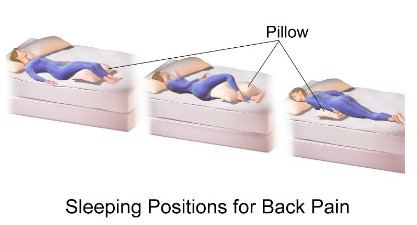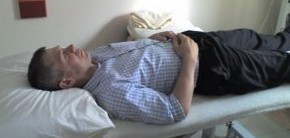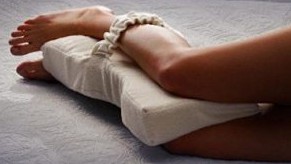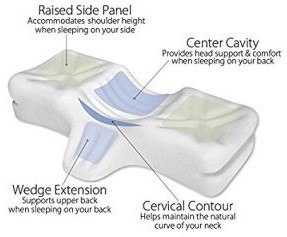Are you dealing with frequent back pain? According to a study done by the Global Burden of Disease, back pain is a primary cause of issues of disability in the world. The study found that most back pain are not caused by severe medical conditions such as arthritis and cancer, rather are brought on by strain, bad posture, and stress as well as lifestyle habits and bad sleeping positions. Many people with severe back pain have sleepless nights, and the pain levels can become vicious leading to more pain and less rest or sleep.
Below are some tips that can help minimize back pain when sleeping. They will work whether you have spinal stenosis, bulging or herniated disc, strain, sciatica, or pregnant. Keep in mind, that at times all it takes is a simple adjustment of the sleeping position to have a restful night with no back pains. Alternatively, you may need to buy a new matters and pillow that offer high comforts and conform to your body form and size.
The Importance of Sleep
Sleep is important for good health. According to the Center for Disease Control (CDC), insufficient sleep is a contributing factor to different conditions such as diabetes, obesity, cardiovascular diseases, and depression. It is also a major contributing factor to many machinery-related crashes, vehicle accidents, and worksite accidents, leading to disability, injury, or even death.
Sleep allows the body to heal as well as the rejuvenation of the spine. It can help you handle stress better and effectively manage pain. It is also critical to good health, which means that ensuring that you enjoy good quality sleep needs to be a priority that is possible.
The Best Sleeping Positions for Back Pain
When it comes to the best sleep position, there is never a “one-size-fits-all” approach like with most things. While side sleepers comprise the majority of the population, it is far from the ideal position for back pain. Here are the 3 sleeping positions ranked from the best to the worst.
1. On the Back
Sleeping on the back is ideal for putting the spine in neutral alignment, but only less than 10 percent of the population sleeps in this position. A few well-placed pillows have the power to boost the benefits of sleeping on the back. A small pillow underneath the neck and head (but not the shoulders) can help keep the spine straight. For additional support and comfort, you can add a pillow under the knees since it encourages the spine to maintain its natural curve.
You can also place a small, rolled up towel under your back for additional support. Your weight is evenly distributed when you sleep on the back. In addition, the weight is spread across the widest area of the body. You will therefore put less strain on the pressure points. You will also get better alignment of the internal organs and spine.
- It is not suitable for those with sleep apnea. Sleeping on the back may cause blockage of the breathing tube by the tongue, which means that those suffering from sleep apnea should not sleep on the back. A better position for such people would be side sleeping with the legs straight.
- It is not suitable for people that snore. Sleeping on the back worsens snoring. People that snore should sleep on the side with the legs straight.
- It is not suitable for pregnant women. Pregnant women that sleep on the back risk developing various health problems, ranging from low blood pressure to back pain. Sleeping on the back also reduces blood circulation to the baby and heart. The most suitable sleep position for pregnant women is on the side with the legs bent.
2. On the Side
Sleeping on the side can be a better position if you have a fairly soft mattress. People suffering from lower back pain find side sleeping the most comfortable sleeping position. If you are a side sleeper, pull up the knees slightly so that they are nearly perpendicular from the body. You might have to make adjustments on how bent the legs are before finding a position that relieves pressure off the back. Place a pillow between the knees and thighs. Without a pillow between the knees, the top leg is likely to drop down and forward thus causing the spine to rotate in an unnatural way.
Using a body pillow provides the best support for people that sleep on the side and keeps the whole body aligned properly. If you don’t use a body pillow, it does help to place a large pillow under the upper arm to support the shoulder better. Placing a small pillow under the waist can also help t alleviate hip and back pain for those that sleep on the side.
3. On the Stomach
Sleeping on the stomach is unfortunately the worst position for those suffering from back pain. It can ease sleep apnea and snoring, but this is perhaps the only good thing about this position. Stomach sleeping tightens the lower back and strains the neck, which puts strain on the vertebrae in the spine’s lumbar region. You should always avoid this sleep position whenever possible.
For a small percentage of people, it is the only way they are able to sleep. If it is a must for you to sleep in this position, you should place a thin pillow under the lower abdomen and pelvis. Avoid using a pillow under the head if it causes a lot of strain on the neck.
Get The Right Pillow
People often disregard the need to invest in good quality pillows when seeking help for their back pain. A pillow under your head accounts for having the right position when sleeping, though not everyone will sleep well with their heads elevated. When placed under the head, the pillow will ensure that you have a natural alignment where your body is positioned in a manner that has your spine and shoulders correlating with your head. But pillows are not only meant to be items you use to rest your head on, but they can also be placed under the knees or the hip to help with back pain. What you use is subject to the type of sleep position you prefer; this will determine the type of pillow to choose and the guidelines of its use.
Under no circumstance should you have a pillow under your shoulders, it will not keep you in the natural alignment. Also, change your pillows every 12- 18 months to avoid using pillows that have accumulated dirt and harbor dust mites and mold.
Invest In A Good Quality Mattress
Never neglect the mattress primarily because it is where you spend your resting hours to allow your body to rest and rejuvenate. A sagging mattress only exasperates the back pain problem by adding to the strain and stress you spine endures, and this makes it harder to sleep soundly.
A firm mattress was believed to be a viable solution for people who dealt with frequent pain in their lower back. It is a belief that had no backing evidence on its effectiveness. The notion of using a firm mattress was dropped recently though there still is little information on the correlation between having a good mattress and dealing with back pain. However, a certain study showed that a medium-foam mattress provided the best relief for lower back pain issues.
Going for the most expensive mattress is not a guarantee that you have made an investment that will alleviate your back pain problem. Instead, invest in a mattress that provides the most comfortable rest and best night’s sleep. It should conform to your body, supporting your spine’s curvature thus ensuring that as you lay down the spine is a position to that it would be in when you are standing.
The objective therein is to provide your back ample support to ensure it is comfortable as you sleep. Use a soft mattress if you tend to sleep on your side so that your hips and shoulders sink into the form to ensure the painful pressure points are not under stress. If you sleep on your back, ensure your weight is evenly distributed and this calls for a firm mattress. If you tend to switch positions, then use a mattress with a medium foam, not too soft nor too firm since such put the back under a lot of strain leading to frequent pain in your lower back.
Again, a medium-firm mattress is the best choice particularly one with a quality foam or innerspring, but the firms should be based on your body weight. A memory foam mattress topper can help enhance the support offered by an innerspring mattress. Buy a new mattress when you feel the need to; some companies allow customers to test their mattresses and mattress toppers on a return policy (usually on a set duration) if they do not like a certain model to try another.
- See Best Mattresses for Chronic Back Pain with Buyer’s Guide
- See Best Mattress Toppers for Back Pain Relief with Buyer’s Guide
Sleep Hygiene Tips
Poor sleep habits are sometimes due our rigidness and reluctance of dropping old habits. Some of these habits include as sleeping in different odd hours during the day, taking stimulants such as coffee or sugary foods (desserts) minutes before bedtime, or even work on the computer or staying on the phone until ten minutes before jumping into bed.
As you lay yourself to rest after the lights go out, the stimuli that kept you active gradually fade and your attention shifts to the pain in your back. Your anxiety builds as you pay more attention to the pain and this makes it harder to sleep.
In your bid to reduce the pain in your lower back, you should consider implementing the following tips.
- Engage in touch and strenuous exercises in the morning or early hours of the day. Do not engage in rigorous activities a few hours to bedtime because they may increase your body temperature and adrenaline levels; two elements that make it hard to fall asleep.
- If you toss and turn all night and then sleep in during the day, you have a sleep schedule that is off. Have a sleep schedule to help you set sleep and wake times that will help your body regain the regular sleeping routine. Ensure that your plan allows you to get not less than eight hours of sleep every night and within the ideal hours of the evening.
- Make your that all electronics especially those that emit light are switched off before you jump into your bed. A blue light will keep you awake and make you toss and turn when in bed. So, use it when you are taking a relaxing bath just before bedtime. Yoga and other quiet hobbies such as knitting and reading can also help you feel relaxed and in the right setting for a restful sleep.
- Listing to soothing music or sounds can also help you sleep. The sounds low your stress and anxiety levels and can redirect your focus away from the pain in your lower back thus allowing you to fall asleep. Classical music, relaxation podcasts as well as children’s audio books and other audio selections that do not have harsh or penetrating plot lines are excellent nighttime audio options worth trying.
- Avoid taking coffee and alcohol or eating or overeating a few hours before bed. Such habits make it hard to sleep and affect your sleeping habits negatively. Also, taking too many liquids just before bedtime will cause you to have many bathroom breaks that will affect your night’s sleep.
- Ensure your bedroom is cool because the low temperatures foster the perfect settings that encourage you to fall asleep quickly. The room should not be too warm or too cold. Taking a hot bath can help warm you up if you feel cold just before bed. The cool temperatures will make you feel relaxed, and this can relieve some of the pain you are experiencing and thus help you sleep better.
Alignment is the Key
It is natural for a person to sleep in the comfiest positions. You may fall asleep in one position and wake up while in a different one. The body will naturally want to feel comfortable when resting. You try and discover which position works best for your body by experimenting with various sleep positions. Try one of two for a few nights periodically switch to other until you find the best fit. It can be on your back, stomach or side; ultimately it is the position that naturally makes the body switch into “snooze mode.”
Irrespective of the position you fit suitable, it is important to ensure that you correctly align your spine, shoulders, and head. A simple strategy that works when sleeping on your back is to have your ears, shoulders, and hip in a perfect alignment. Gaps between your body and the mattress are an indication of misalignment or use of a poor mattress, and these will strain your spine and muscles leading to back pains. The alignment may go off as you twist and turn while asleep, but your body will do its best to find a comfortable position that keeps your core tight and pulled in. If you sleep on your sides, curl your knees up bringing them towards the chest.












